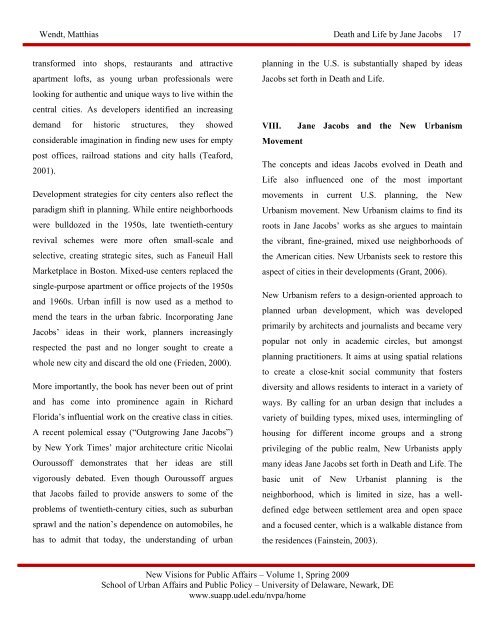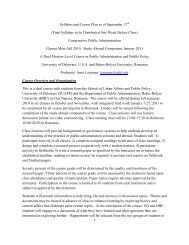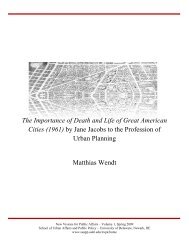New Visions for Public Affairs Volume 1 - School of Public Policy ...
New Visions for Public Affairs Volume 1 - School of Public Policy ...
New Visions for Public Affairs Volume 1 - School of Public Policy ...
Create successful ePaper yourself
Turn your PDF publications into a flip-book with our unique Google optimized e-Paper software.
Wendt, Matthias Death and Life by Jane Jacobs 17<br />
trans<strong>for</strong>med into shops, restaurants and attractive<br />
apartment l<strong>of</strong>ts, as young urban pr<strong>of</strong>essionals were<br />
looking <strong>for</strong> authentic and unique ways to live within the<br />
central cities. As developers identified an increasing<br />
demand <strong>for</strong> historic structures, they showed<br />
considerable imagination in finding new uses <strong>for</strong> empty<br />
post <strong>of</strong>fices, railroad stations and city halls (Tea<strong>for</strong>d,<br />
2001).<br />
Development strategies <strong>for</strong> city centers also reflect the<br />
paradigm shift in planning. While entire neighborhoods<br />
were bulldozed in the 1950s, late twentieth-century<br />
revival schemes were more <strong>of</strong>ten small-scale and<br />
selective, creating strategic sites, such as Faneuil Hall<br />
Marketplace in Boston. Mixed-use centers replaced the<br />
single-purpose apartment or <strong>of</strong>fice projects <strong>of</strong> the 1950s<br />
and 1960s. Urban infill is now used as a method to<br />
mend the tears in the urban fabric. Incorporating Jane<br />
Jacobs’ ideas in their work, planners increasingly<br />
respected the past and no longer sought to create a<br />
whole new city and discard the old one (Frieden, 2000).<br />
More importantly, the book has never been out <strong>of</strong> print<br />
and has come into prominence again in Richard<br />
Florida’s influential work on the creative class in cities.<br />
A recent polemical essay (“Outgrowing Jane Jacobs”)<br />
by <strong>New</strong> York Times’ major architecture critic Nicolai<br />
Ourouss<strong>of</strong>f demonstrates that her ideas are still<br />
vigorously debated. Even though Ourouss<strong>of</strong>f argues<br />
that Jacobs failed to provide answers to some <strong>of</strong> the<br />
problems <strong>of</strong> twentieth-century cities, such as suburban<br />
sprawl and the nation’s dependence on automobiles, he<br />
has to admit that today, the understanding <strong>of</strong> urban<br />
planning in the U.S. is substantially shaped by ideas<br />
Jacobs set <strong>for</strong>th in Death and Life.<br />
VIII. Jane Jacobs and the <strong>New</strong> Urbanism<br />
Movement<br />
The concepts and ideas Jacobs evolved in Death and<br />
Life also influenced one <strong>of</strong> the most important<br />
movements in current U.S. planning, the <strong>New</strong><br />
Urbanism movement. <strong>New</strong> Urbanism claims to find its<br />
roots in Jane Jacobs’ works as she argues to maintain<br />
the vibrant, fine-grained, mixed use neighborhoods <strong>of</strong><br />
the American cities. <strong>New</strong> Urbanists seek to restore this<br />
aspect <strong>of</strong> cities in their developments (Grant, 2006).<br />
<strong>New</strong> Urbanism refers to a design-oriented approach to<br />
planned urban development, which was developed<br />
primarily by architects and journalists and became very<br />
popular not only in academic circles, but amongst<br />
planning practitioners. It aims at using spatial relations<br />
to create a close-knit social community that fosters<br />
diversity and allows residents to interact in a variety <strong>of</strong><br />
ways. By calling <strong>for</strong> an urban design that includes a<br />
variety <strong>of</strong> building types, mixed uses, intermingling <strong>of</strong><br />
housing <strong>for</strong> different income groups and a strong<br />
privileging <strong>of</strong> the public realm, <strong>New</strong> Urbanists apply<br />
many ideas Jane Jacobs set <strong>for</strong>th in Death and Life. The<br />
basic unit <strong>of</strong> <strong>New</strong> Urbanist planning is the<br />
neighborhood, which is limited in size, has a welldefined<br />
edge between settlement area and open space<br />
and a focused center, which is a walkable distance from<br />
the residences (Fainstein, 2003).<br />
<strong>New</strong> <strong>Visions</strong> <strong>for</strong> <strong>Public</strong> <strong>Affairs</strong> – <strong>Volume</strong> 1, Spring 2009<br />
<strong>School</strong> <strong>of</strong> Urban <strong>Affairs</strong> and <strong>Public</strong> <strong>Policy</strong> – University <strong>of</strong> Delaware, <strong>New</strong>ark, DE<br />
www.suapp.udel.edu/nvpa/home







